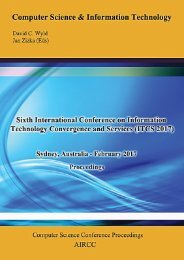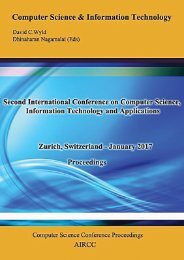CoSIT 2017
Fourth International Conference on Computer Science and Information Technology ( CoSIT 2017 ), Geneva, Switzerland - March 2017
Fourth International Conference on Computer Science and Information Technology ( CoSIT 2017 ), Geneva, Switzerland - March 2017
You also want an ePaper? Increase the reach of your titles
YUMPU automatically turns print PDFs into web optimized ePapers that Google loves.
HANDWRITTEN CHARACTER<br />
RECOGNITION USING STRUCTURAL<br />
SHAPE DECOMPOSITION<br />
Abdullah A. Al-Shaher 1 and Edwin R. Hancock 2<br />
1 Department of Computer and Information Systems, College of Business<br />
Studies, Public Authority for Applied Education and Training, Kuwait<br />
2 Department of Computer Science, University of York, York, United Kingdom<br />
ABSTRACT<br />
This paper presents a statistical framework for recognising 2D shapes which are represented as<br />
an arrangement of curves or strokes. The approach is a hierarchical one which mixes geometric<br />
and symbolic information in a three-layer architecture. Each curve primitive is represented<br />
using a point-distribution model which describes how its shape varies over a set of training<br />
data. We assign stroke labels to the primitives and these indicate to which class they belong.<br />
Shapes are decomposed into an arrangement of primitives and the global shape representation<br />
has two components. The first of these is a second point distribution model that is used to<br />
represent the geometric arrangement of the curve centre-points. The second component is a<br />
string of stroke labels that represents the symbolic arrangement of strokes. Hence each shape<br />
can be represented by a set of centre-point deformation parameters and a dictionary of<br />
permissible stroke label configurations. The hierarchy is a two-level architecture in which the<br />
curve models reside at the nonterminal lower level of the tree. The top level represents the curve<br />
arrangements allowed by the dictionary of permissible stroke combinations. The aim in<br />
recognition is to minimise the cross entropy between the probability distributions for geometric<br />
alignment errors and curve label errors. We show how the stroke parameters, shape-alignment<br />
parameters and stroke labels may be recovered by applying the expectation maximization EM<br />
algorithm to the utility measure. We apply the resulting shape-recognition method to Arabic<br />
character recognition.<br />
KEYWORDS<br />
point distribution models, expectation maximization algorithm, discrete relaxation, hierarchical<br />
mixture of experts, Arabic scripts, handwritten characters<br />
1. INTRODUCTION<br />
The analysis and recognition of curved shapes has attracted considerable attention in the<br />
computer vision literature. Current work is nicely exemplified by point distribution models [1]<br />
and shape-contexts [2]. However, both of these methods are based on global shape-descriptors.<br />
This is potentially a limitation since a new model must be acquired for each class of shape and<br />
this is an inefficient process. An alternative and potentially more flexible route is to use a<br />
structural approach to the problem, in which shapes are decomposed into arrangements of<br />
Dhinaharan Nagamalai et al. (Eds) : <strong>CoSIT</strong>, SIGL, AIAPP, CYBI, CRIS, SEC, DMA - <strong>2017</strong><br />
pp. 39– 47, <strong>2017</strong>. © CS & IT-CSCP <strong>2017</strong><br />
DOI : 10.5121/csit.<strong>2017</strong>.70405





